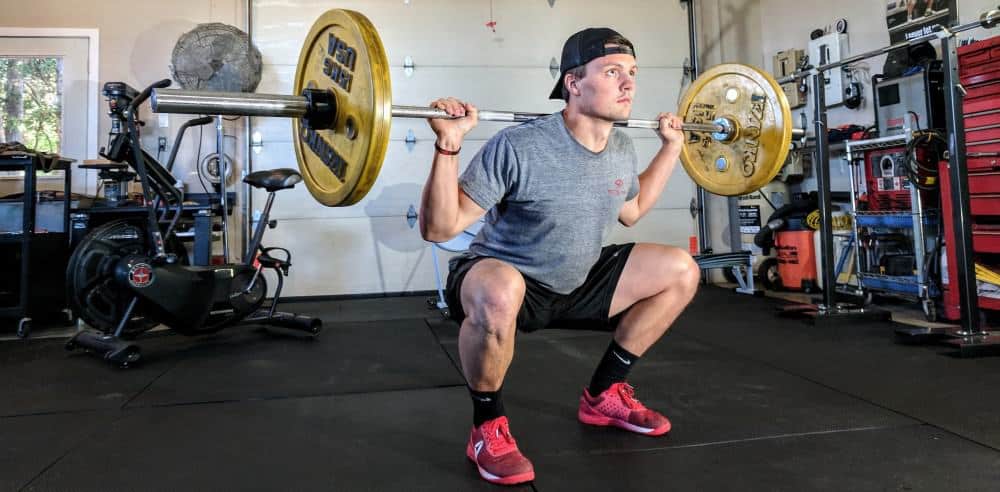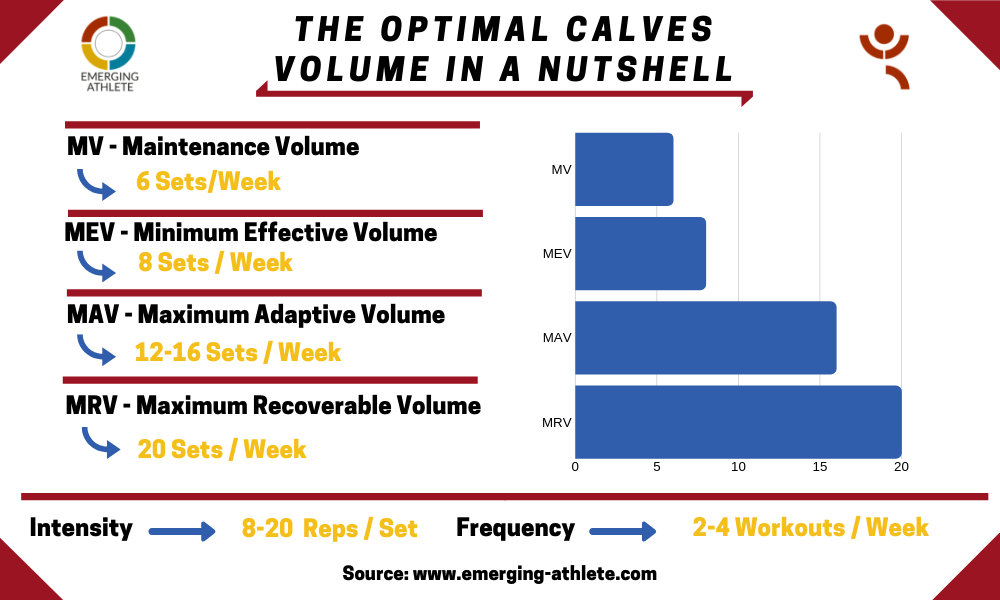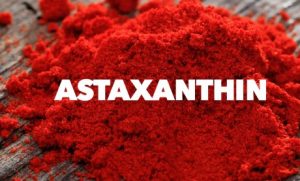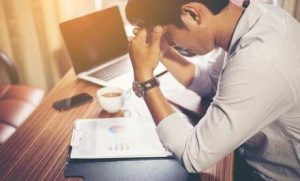Do you belong to the sort of people, who work out but still cannot get their calves to grow?
or are you one of the rare exceptions with jacked up calves?
Most individuals probably see themselves in the former illustration, including me by the way.
To help all of you that belong to the former category, in this way also myself, today we’ll take a look at the optimal calves volume. So that finally the hard work pays off.
Ensuring that all the sweat, blood and tears expended at the gym be worthwhile.
Then you want to read this article!

If you still have some questions about volume, what it concerns, how it affects muscle growth and what particular is required to pay attention to, I highly recommend you to check out our free guide about the optimal volume for hypertrophy.
What can you expect from this article and in general our whole volume series?
Based on Dr Mike Israetel’s knowledge and experience, as well as our own, we want to clarify which volume works best for each muscle.
Without further ado, let’s dig into the world of calves.
First and foremost, why is it common that most individuals have small or even “no calves” at all?
And are all people with big, giant calves genetic miracles?
Stay tuned if you’re having similar issues like either stagnant or flat progress or no growth at all…
Calves are known as one of, maybe even the hardest muscles to add size. Despite the fact that a lot of people are doing heavy squats and isolation work for them, nothing really seems to happen.
On the contrary, there are people who don’t even look at their calves but have giant, massive calves…
How is that possible?
The important thing about calves is muscle fiber composition.
There are two different types: slow-twitch and fast-twitch muscle fibers.
How do they differentiate?
Fibers known as “fast-twitch” tend to have a higher potential for growth and force output, but in contrast fatigue relatively quickly.
Fibers known as “slow-twitch” muscle fibers tend to be the opposite. They have a lower potential for growth and force output but are relatively resistant to fatigue and can, therefore, sustain more than “fast-twitch” muscle fibers.
With regard to that, research shows that calves composition can vary greatly individually.
On average, 80% of calves are composed of slow-twitch muscle fibers. Therefore, it seems that exposure to forces with relatively moderate weight over a longer period of time is more effective than exposure to short and heavy forces.
If we consider us human beings, it even makes more sense.
What’s the foundation on what we’re walking all day every day?
Exactly, our legs and not on our hands (maybe some crazy dudes but not me…). Downstairs where the calves are located, it comes down to carry all our body over a sometimes elusive long duration.
With that in mind, we understand the basics of how our calves work and probably respond most effectively to incentives.
Thus, if you’re only doing heavy squats, deadlifts and that kind of stuff which indeed is awesome for the lower body. However, it tends to be not working well to get jacked up calves.
MV – Maintenance Volume
What does MV mean?
MV refers to Maintenance Volume which indicates the amount of work that is required to maintain your muscle’s current size.
Why is it important to know your MV?
That can be answered relatively easily.
If you have to reduce your workouts for a certain period, you don’t want to lose your hard acquired gains, do you? This is why it’s important to know how much volume you need to maintain your shape.
Furthermore, after a period of exhausting, heavy workouts in between your MAV and MRV or even above, it is for sure a good thing or even indispensable to lower your volume to desensitize your body again and fully recover.
Such phases, so-called “deload” often occur after 4-5 weeks of your mesocycle. On average, you reduce your usual weights about 40-50% and training by keeping the number of sets even but using higher reps so to ensure execution safely.
As a result, your body can recover and when starting your new mesocycle, you’re in charge of full strength. Either way, you need to change exercises over time to stimulate growth. As a rule of thumb, beginners can consider switching exercises every 2-3 mesocycles. Advanced athletes could even replace
Concluding, it is crucial to know the MV and what you can use as benchmarks to ensure you don’t lose any muscles.
Also, something that gets underestimated quickly, is keeping the volume appropriate low during the “deload phase”, which often tends to be too high.
Now that we understand why it’s important to know, what’s the MV for the optimal calves volume?
MV: 6 sets/week
On average 6 sets/week tend to be sufficient for most people. That actually doesn’t sound like much, and certainly is not.
3 sets of heavy calf work on Monday and 3 sets of heavy calf work on Thursday should keep them the same size.
Again, before we continuing all these benchmarks, these are average figures and not fixed, rigid values. It is very important that you experiment yourself and track progress on what works best for your body. This applies to all the following values.
MEV – Minimum Effective Volume
What does MEV mean?
Minimum Effective Volume relates to the least amount of work that is necessary to stimulate some muscle growth.
Why is it important to know your MEV?
Briefly speaking, just like it’s important to know how much volume your calves need to maintain its current size, it is at least of similar importance to know how much volume is required to grow them.
What is enough to stimulate calves growth?
MEV: 8 sets/week
About 8 sets/week tend to be a good start for your mesocycle training program. This could look like: 4 sets of heavy calves work on Monday and the remaining 4 sets on Thursday.
If you start with 8 sets/week, work your way up during the weeks and consistently increase the volume gradually, but don’t exaggerate too quickly.
Don’t make the same mistake as a lot of people do.

MAV – Maximum Adaptive Volume
What does MAV mean?
In a nutshell, MAV relates to the Maximum Adaptive Volume which reveals the amount of work where probably most of the muscle growth will happen, on average.
Why is it important to know your MAV?
I highly doubt that you want to train all the time with merely the least effective muscle growth? Am I correct with that?
In order to provoke the best muscle growth effect, we need to put more effort into our workout and increase the volume consistently over time.
That is why it is important to know what the MAV is and also which benchmark we can refer to, to maximize your muscle growth effect.
A good way to approach your mesocycles can be as follows:
Starting your first week around your MEV, during the next two weeks your consistently adding volume until reaching MAV and eventually, even overreach your MRV to round off the mesocycle. After that, you can or might need to do a week of deload workout and then start again.
So, whats a good MAV benchmark for the optimal calves volume?
MAV: 12-16 sets/week
Between 12-16 sets/week is the average amount of work to get your calves in shape. In this area, most of the growth happens, benefitting you with some nice looking calves.
MRV – Maximum Recoverable Volume
What does MRV mean?
Maximum Recoverable Volume, which refers to the maximum amount of work that can be fully recovered without taking a loss in performance.
In other words, the maximum amount of work that your body can sustain until your strength and performance may even decrease because your body isn’t able to fully recover from the current volume.
Sooner or later in your mesocycle program, you will reach a point where progress isn’t going as fast anymore and your performance beings to stagnate or even decrease.
This is an indication that you probably overreached your MRV.
Why is it important to know your MRV?
Considering all the above-mentioned aspects, that is pretty straightforward.
Who wants to take unnecessary breaks from training?
I suppose nobody wants that, wherefore it’s so substantial to know what and where your MRV is to avoid preventable breaks and overreaching too quickly.
On that note, what’s a good MRV benchmark for the optimal calves volume?
MRV: 20 sets/week
On average, the Maximum Recoverable Volume for calves is about 20 sets/week.
This is quite a lot of work, but how much volume is recoverable for you, is extremely individual. It depends on the muscle fiber composition of your calves, as well as the demanded recovery time.
Frequency
How frequent should we train calves for the optimal calves volume?
2-4 workouts/week
Regarding frequency for calves, it really depends on your body type. Some folks need more time to recover their calves for what reason around 2 workouts/week is sufficient for them.
Other people can sustain more frequency and don’t need as long to recover. For them, frequencies varying from 2 up to 4 workouts/week works fine.
In training, the individual aspect is always of great significance.
Intensity
How heavy should we train calves for the optimal calves volume?
8-20 reps/set
Why not any heavier than 8 reps/set?
It is very likely that with heavier weights and any less than 8 reps/set technique will suffer as a lot of people tend to get sloppy towards the end. Obviously, it gets tougher the heavier the weight is to maintain proper execution. Eventually, it only involves some more swing from our quads and doesn’t result in effective calves stimulation anymore.
Calves workout – Exercises
After we’ve talked a lot about theory, frequency, volume, etc. of course, we need to take a look at the practical side of the coin.
Which exercises should you be doing and what works?
In the following, I’ll list you a couple of my favorite exercises for the optimal calves volume.
- Standing calf raises (Smith Machine or variations)
- Standing calf raises without equipment / or with dumbbell/barbell (one calf at a time)
- Sitting calf raises (Machine)
- Calf raises on a leg press machine
- Donkey calf raises (Smith Machine or variations)
If we had to choose between standing, bent, and sitting calf exercises, I would definitely recommend standing or sitting ones.
Why is that?
Here’s the deal.
Calves are composed of two powerful muscles: the soleus and the gastrocnemius.
Bent leg takes the gastrocnemius almost completely out of the movement and is simply an entirely soleus focused exercise.
The soleus is closer to your ankle and doesn’t tend to grow a lot. Furthermore, it neither gives you such a nice look that we’re aiming for.
The gastrocnemius is forming the diamond shape part. It makes your calves look big and aesthetic.
Therefore, I recommend focussing most of your calves training on standing exercises for the gastrocnemius and only some additional, secondary work, on the soleus.
Is your favorite calf exercise missing?
Share your experience and knowledge with us and leave a comment below!
Range of Motion
What about the range of motion?
Well, range of motion is always a big deal. For some muscles more for other less, but in general, you won’t go wrong with a proper stretch. If you take exercises through full stretch and range of motion, it will almost always increase your growth.
Especially for calves, a deep and painful stretch is essential. So make sure to go all the way down and all the way up.
Conclusion
To finish this article about the optimal calves volume, I really want to make a point here.
Growing calves is a process that takes a long time.
You’ve been using your calves to walk around your whole life. They take a long time to grow, be patient with it and slowly get stronger in the moderate rep range with full and deep stretch!
Lastly, what are the most important take-home key points?

Exercises: Some of my favorite exercises are listed down below.
- standing calf raises (smith machine or other variations),
- sitting and bent calf raises (machine or other variations) or
- calf raises on a leg press machine.
Range of Motion: Especially for calves, a deep and painful stretch is crucial, wherefore weight definitely comes second regarding calves training.
Practical Tips
For calves, techniques like a super, drop or giant sets don’t work as well as for other muscles.
Nonetheless, that doesn’t mean that you can’t or shouldn’t use them, you can do it from time to time but on average, there is a more effective tip for the optimal calves volume.
Short rest times: Calves are a really small muscle. Training calves compared to heavy compound exercises like squats or deadlifts, it isn’t nearly as exhausting and fatiguing.
This is why short rest times is a good thing to do because you don’t need to wait 3-5 minute being ready for the next set. I would recommend keeping your rest breaks between 45-60 seconds on average.
Special shout-out to Dr. Mike Israetel, we really value his knowledge and the content that he shares with you guys on his YT channel and his blog.
Definitely check out his video about calves volume!
How often do you train your calves?
Leave a comment below and let us know about your personal experiences!
For any further questions, please feel free to contact us, either via our social media channels or in the comment section below.
See you guys next time, with hopefully bigger calves 😉
Cheers,
Claas




